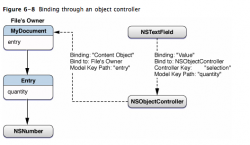Getting started with Bindings. I am going through Hillegass, but I constantly find myself darting off at a tangent, to figure out what he means. But they speak about him in religious terms, so I am sticking with it.
This little tangent was to get a somewhat deeper insight into bindings.
It's an example from the Apple documentation.
http://developer.apple.com/documentation/developertools/Conceptual/IB_UserGuide/ConnectionsandBindings/ConnectionsandBindings.html
I got the example to work, but I am confused by 2 concepts
Figure 6-8 shows the general layout

The view that is confusing is this one.

Specifically, the "Controller Key" selection. The documentation says this about selection.
Now...I am not even sure if this is relevant, but if it is, I wonder if someone could explain this. ( I notice I am not alone in this as many have asked before but it has almost never been answered with a good answer)
Secondly...using the controller, I see that the NSTextField is directly bound to "quantity" in the Model Key Path. I know they say that the NSOC acts as a proxy for "MyDocument", but could someone perhaps just elaborate on this too.
Much appreciated.
This little tangent was to get a somewhat deeper insight into bindings.
It's an example from the Apple documentation.
http://developer.apple.com/documentation/developertools/Conceptual/IB_UserGuide/ConnectionsandBindings/ConnectionsandBindings.html
I got the example to work, but I am confused by 2 concepts
Figure 6-8 shows the general layout

The view that is confusing is this one.

Specifically, the "Controller Key" selection. The documentation says this about selection.
Return Value
A proxy object representing the receivers selection. This object is fully key-value coding compliant, but note that it is a proxy and so does not provide the full range of functionality that might be available in the source object.
Now...I am not even sure if this is relevant, but if it is, I wonder if someone could explain this. ( I notice I am not alone in this as many have asked before but it has almost never been answered with a good answer)
Secondly...using the controller, I see that the NSTextField is directly bound to "quantity" in the Model Key Path. I know they say that the NSOC acts as a proxy for "MyDocument", but could someone perhaps just elaborate on this too.
Much appreciated.

